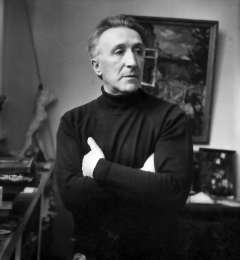The artist and prose writer Abram Rabkin was born in Bobruisk (Belorussia) in 1925. After finishing a general education school there, he attended a studio for visual arts. Abram's father Isaak was arrested in 1937, at the height of the Great Terror. Isaak Rabkin hanged himself, unable to endure the torture and pressure to be a false witness. The father's fate affected the young Abram, and would later come to have a great influence on his art.
At the very beginning of the Soviet-German War, one day before the occupation of Bobruisk by German troops (June 28, 1941), Abram managed to flee together with his mother and sister. The Jews who remained in the city perished.
In 1943, concealing his age, the 17-year-old Rabkin successfully volunteered for frontline duty, taking part in combat and being seriously wounded. He was discharged from the Red Army in 1946.
Following his demobilization, Abram Rabkin began to study at the Valentin Serov Art School in Leningrad. After graduating, he stayed in the city. In 1962, Rabkin became a member of the Union of Artists of the USSR.
Abram Rabkin took part in art exhibitions in Leningrad, Moscow, Minsk, and Bobruisk – and later (in the 1990s and 2000s) also in Israel and the United States. He held his first personal exhibition in Leningrad in 1981. Titled "The City of My Childhood," it included works devoted to shtetls and to his native Bobruisk. Subsequently, the exhibition was also displayed in Bobruisk and Minsk.
In the late 1990s, he published a book titled Vniz po Shosseinoi [Along Shosseinaia Street], which described prewar Bobruisk.
In 2010, in honor of his 85th birthday, Bobruisk held an exhibition of his works titled "I Am of the Generation of the War."
Abram Rabkin died in St. Petersburg (Russia) in 2013.







